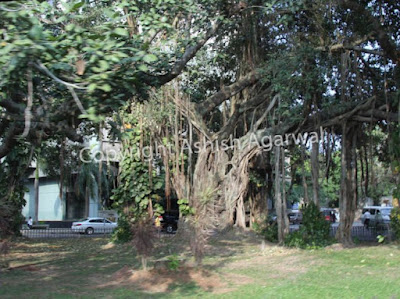The Living Giant: A Banyan Tree with Endless Aerial Roots
In the heart of the city, where cars hum and buildings rise, stands a giant.
Its massive limbs stretch wide, thick with history.
From its branches hang countless aerial roots, weaving a silent curtain between the earth and the sky.
Captured in this image, the banyan tree is a living sculpture, a monument built by time and nature.
The Magic of Aerial Roots: Nature’s Natural Bridges
One of the most striking features of the banyan tree is its aerial prop roots.
Unlike most trees, which grow straight from a single trunk, the banyan tree sends down roots from its branches.
These roots hang like thin ropes at first, swaying gently in the wind. Over time, they thicken, harden, and anchor themselves into the ground—becoming secondary trunks.
It is this unique behavior that allows banyan trees to spread sideways over massive areas, creating a forest from a single tree.
The aerial roots serve many purposes:
-
Support: They prop up heavy horizontal branches, preventing them from breaking.
-
Expansion: They allow the tree to grow wider and cover more ground.
-
Survival: In dense forests or urban areas, aerial roots help banyans adapt to changing conditions.
Walking beneath a banyan feels like stepping into a natural cathedral, the light filtering through layers of trunks and branches.
How Big Can Banyan Trees Grow?
Banyan trees are among the largest trees in the world—not necessarily in height, but in canopy spread.
Some famous examples include:
-
The Great Banyan Tree in Kolkata, India, which covers over 3.5 acres (around 14,000 square meters). It looks like a forest but is actually one tree!
-
The Thimmamma Marrimanu in Andhra Pradesh, believed to cover nearly 5 acres and considered one of the oldest and largest banyans globally.
A single banyan can support thousands of aerial roots, creating a network of trunks and sheltering entire ecosystems beneath its shade.
Other Trees and Plants with Aerial Prop Roots
While banyans are famous for their spectacular aerial roots, they aren't the only plants that use this strategy.
-
Mangroves: Found in coastal swamps, mangrove trees use aerial roots to stabilize themselves in soft, shifting mud.
-
Strangler figs: These start as vines and send down roots that eventually encase and overtake host trees.
-
Screw pines (Pandanus): These tropical plants develop prop roots to support their upright stems in loose or sandy soils.
In all these examples, aerial roots are about survival and strength—nature's way of making sure life finds a foothold, even in challenging conditions.
The Importance of Banyan Trees in Civilization and Culture
Throughout human history, the banyan tree has been much more than just a plant.
It has been a symbol, a gathering place, and a spiritual landmark.
In Indian culture, the banyan tree is deeply revered:
-
It is associated with immortality and eternal life. Hindu mythology often describes sages meditating under its expansive branches.
-
The banyan is considered the dwelling place of Lord Krishna and is mentioned in ancient scriptures like the Bhagavad Gita.
-
Villages often grew around banyan trees. These trees served as meeting points for councils, marriages, festivals, and community gatherings.
In many Asian cultures, the banyan is seen as a connection between heaven and earth—a reminder of how life is both grounded and soaring.
Even today, old banyan trees are protected by custom and law in many parts of the world.
An Abstract Beauty: The Spirit of the Banyan Tree
For those who appreciate abstract photography and art, the banyan offers endless inspiration.
-
The twisting, looping aerial roots create organic patterns against the sky.
-
The dense layering of trunks and leaves forms a natural maze of light and shadow.
-
The way the branches reach out—not just upward but outward—feels like an embrace.
Every banyan tree tells a story written in living wood.
A story of growth, endurance, and quiet strength.
Standing beneath a banyan tree, you feel both small and safe—as if you are a part of something ancient and wise.
Lessons We Learn From the Banyan Tree
The banyan tree, with all its sprawling complexity, teaches us powerful lessons:
-
Adaptability: Life will find ways to grow, even in unlikely places.
-
Community: Strength often comes from many supporting one another.
-
Endurance: True greatness grows slowly but lasts for centuries.
Just like its aerial roots descend quietly from above and change the very landscape they touch, small, consistent actions can shape the world around us in profound ways.
Closing Reflection
In a world that often values the fast and the flashy, the banyan reminds us of the beauty of patience.
Of slow, steady expansion.
Of deep connections that hold firm through storms and seasons.
The banyan tree isn't just a tree.
It’s a living legacy—a bridge between earth and sky, between past and present.
And when you stand beneath its canopy of twisted roots and thick green leaves, you feel it:
The silent, steady heartbeat of nature, echoing through time.
Want to get tips for improving your photography ? Get Photo Tips from this blog.









 RSS
RSS
